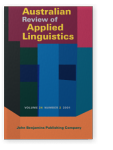Vol. 24:2 (2001) ► pp.61–80
The cultural significance of coda in Chinese Narratives
In Western studies of narrative, Complication, Resolution and Evaluation have received a substantial amount of attention whereas Coda is regarded as an optional and relatively insignificant element. This paper analyzes narratives written by Grade 5/6 students in Hong Kong and investigates some of the contextual factors which help to shape the production and interpretation of these narrative texts. Findings suggest that the functions of Coda are culture-specific. In Chinese narratives, Coda is an obligatory element. It is important because of its role as a carrier of value-laden messages. It is the locus where the social purpose of Chinese narrative is stated, and where the cultural meaning of narrative texts is expressed. It provides a mechanism through which a process of self-reflection and self-discovery is instated so that what one experiences in the external world is given some significance. This process of self-discovery is extended to others through processes of moralization and generalization so that a general discovery of truth will result. The paper also demonstrates how the significance of Coda is conveyed through teachers’ beliefs and teaching practices.
